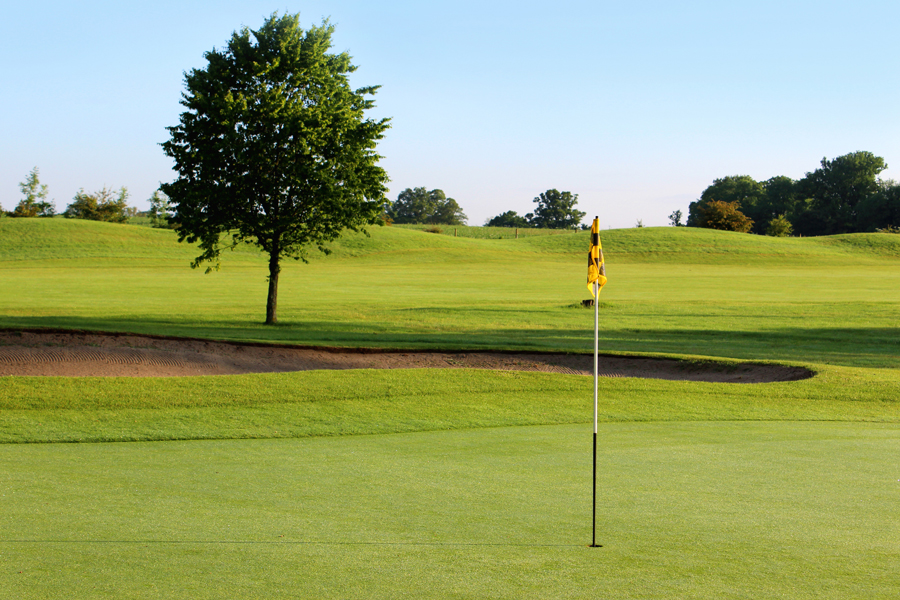Crop and Soil Sciences
-

Producing and/or purchasing hay to feed livestock through the winter represents a substantial expense. This publication details strategies and considerations when stockpiling and utilizing tall fescue.
Dennis Hancock
|
-

Recently, switchgrass has attracted attention as a potential bioenergy crop. High yields of biomass with relatively few inputs make switchgrass a favorable choice for bioenergy production. In contrast, the use of switchgrass in pastures and hayfields in Georgia is limited because other introduced species (e.g., bermudagrass, bahiagrass, tall fescue, etc.) are more easily managed for high yields and forage quality. This publication provides basic information about switchgrass and its use as a bioenergy crop, forage crop, and wildlife habitat.
Dennis Hancock
|
-

This publication contains a financial analysis of alternatives to methyl bromide and mulch for bell pepper in Georgia. This research is aimed at seeking the best fumigant substitute for methyl bromide (MB) along with the perfect mulch complement that effectively enhances production yield and profitability potential. The main goal of this report is to make the alternatives accessible to farmers
through different planning budgets they could use in decision making.Stanley Culpepper, Cesar L. Escalante, Esendugue Greg Fonsah, and Clarisse Ferrer
|
-

The goal of this publication is to guide the user to a better understanding of basic forage quality terms and to recommend management changes that will improve forage quality. To that end, our objectives are to explain how forage quality is measured, describe how to interpret a forage analysis, present the effects of management on forage quality, and list the key management strategies that can increase the nutritive value of forage crops.
Dennis Hancock, John K. Bernard, Lawton Stewart, Uttam K. Saha, and Bobby Smith
|
-

B 911
Bermudagrass in Georgia
Bermudagrass (Cynodon spp.) is an important warm-season, perennial, sod-forming forage grass in Georgia and throughout the Southeast. Bermudagrass is productive from spring until fall and is well-suited for grazing or hay production. Several varieties of bermudagrass are used in Georgia, ranging from common bermudagrass to the high-yielding, good quality hybrid bermudagrasses. The best variety to use depends on your location in the state and the intended use.
R. Dewey Lee, Dennis Hancock, Patrick E McCullough, Glendon H. Harris, and Timothy R. Murphy
|
-

This research report presents the results of the 2016 statewide performance tests of soybean, sorghum grain and silage, and summer annual forages. The tests for various evaluations were conducted at several or all of the following locations: Tifton, Plains, and Midville in the Coastal Plain region; Griffin and Athens in the Piedmont region; and Calhoun in the Limestone Valley region.
The University of Georgia soybean variety trials are irrigated. In addition, dryland soybean variety trials were conducted at four locations (Midville, Plains, Tifton, and Griffin), and irrigated, ultra-late planted soybean variety trials were conducted at Midville and Attapulgus. All are included in this report.
Agronomic information, such as plant height, lodging, and disease occurrence, is listed along with the yield data. Information concerning planting and harvest dates, soil type, and culture and fertilization practices used in each trial is included in footnotes. Since the average yield for several years gives a better indication of a variety’s potential than one year’s data, multiple-year yield summaries have been included.
James LaDon Day, John Gassett, Dustin G Dunn, and Henry Jordan
|
-

SB 63-10
2016 Tobacco Research Report
This report contains the most recent results of tobacco research programs at the University of Georgia in 2016.
Anna K Watson
|
-

As tipping fees have risen, interest has increased in finding alternative uses for construction wastes. Many homebuyers are also looking for environmentally sensitive building practices. This includes the recycling and reuse of construction debris rather than disposal. One of the largest waste components in residential construction is gypsum wallboard. In many cases, scrap wallboard can be ground and beneficially applied on the construction site, rather than transported to the landfill.
Julia W. Gaskin and Clint Waltz
|
-

A good pasture and forage program can provide quality feed and normally will be the most efficient and economical means of providing a substantial part of equine rations. In Georgia, we are fortunate to have a mild climate, soils suitable for producing forages and a good selection of highly productive forage species. With careful planning and good management, adequate grazing can be supplied for up to 10 months of the year in most areas of the state. To many producers, the term “horse pasture” denotes grazing management and forage crops unique to horses. This is not the case at all. Because the horse is a herbivore, most forage crops commonly used for cattle can also be used to provide grazing for horses.
John G Andrae
|